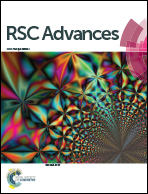Knitting polycyclic aromatic hydrocarbon-based microporous organic polymers for efficient CO2 capture†
Abstract
In order to achieve efficient CO2 capture, four novel microporous organic polymers, based on distinct polycyclic aromatic hydrocarbons such as fluoranthene, binaphthalene, naphthalene and phenanthrene, were successfully prepared by the solvent knitting method. N2 sorption isotherms indicate that these polymers are predominately microporous with ultrahigh BET surface area i.e., 1788 m2 g−1 for fluoranthene-based Polymer 1, 1702 m2 g−1 for binaphthalene-based Polymer 2 and objective CO2 uptake capacity of 24.79 wt% and 20.19 wt% (273.15 K/1.00 bar) respectively. While compared with the former two polymers, though 1227 m2 g−1 and 978 m2 g−1 are moderate in surface area, however the naphthalene-based Polymer 3 and phenanthrene-based Polymer 4 still exhibit CO2 adsorption of up to 17.44 wt% and 18.15 wt% respectively under the similar conditions. Moreover, the H2 storage and CH4 adsorption in these polymers can be 2.20 wt% (77.3 K/1.13 bar) and 2.79 wt% (273.15 K/1.00 bar). More significantly, the electron-rich PAHs are proved to be new building blocks that provide a wealth of chances to produce hypercrosslinked polymers with efficient gas adsorption capacity, which are greatly influenced by the porous nature of polymers. Given the merits including mild reaction conditions, low cost, high surface area, impressive gas absorption performance, high thermal stability, these polymers are considered to be promising candidates for CO2 capture and energy storage under more practical conditions.



 Please wait while we load your content...
Please wait while we load your content...